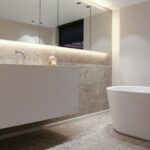In an era where the aesthetics of our living spaces play a crucial role, the demand for honed concrete has soared.
This beautiful, smooth surface adds a sleek, modern touch to any area and boasts durability that can withstand the test of time.
But what exactly goes into achieving that perfectly honed concrete surface?
This guide will walk you through the basics of concrete grinding and polishing — from the initial grind to the final polish.
How to Achieve a Smooth Finish on Your Honed Concrete
Here are simple steps you can follow to give your honed concrete the smooth finish it deserves:
- Inspect & Prep: Check for flaws and clean the surface.
- Initial Grinding: Use a coarse diamond grinder to expose aggregate.
- Progressive Grits: Shift to finer grits to smoothen imperfections.
- Honing: Use the finest abrasives for a smooth finish; clean thoroughly afterwards.
- Seal: Choose and apply a concrete sealer based on preference.
- Regular Maintenance: Regularly clean and reseal your honed concrete for longevity.
What Is Honed Concrete?
Honed concrete is a type of concrete that presents a matte finish that retains a smooth touch without the high gloss.
This flooring option involves grinding the existing concrete surface with diamond-infused pads until it achieves a uniformly smooth texture.
The process allows for the aggregate within the concrete mix to be exposed at varying levels depending on the depth of honing preferred.
Whether for an outdoor entertainment area or around a pool, honed concrete makes a stunning, skid-resistant choice.
Step-by-Step Techniques for Honing Concrete for a Smooth Finish
Achieving a smooth, honed concrete surface involves several meticulous steps.
Here’s a detailed step-by-step guide to ensure your concrete floors are honed to perfection:
1. Inspect and Prepare the Concrete Surface
Before initiating the grinding process, you should first inspect your existing concrete slab for cracks, chips, or any imperfections.
Repair these flaws to create a stable foundation for honing. Remove any existing coatings, paints, or sealers, as they can impede the grinding and honing processes. Ensure the surface is clean and devoid of debris.
2. Initial Grinding Phase
Begin with a coarse diamond grinding pass. Using a concrete grinder equipped with diamond-segmented abrasives, start grinding the surface of the concrete.
This initial grind removes the top layer of the concrete, exposing the aggregate beneath and preparing the surface for finer honing.
Remember to move evenly across the floor to avoid creating dips or uneven areas.
3. Progress Through Grinding Grits
After the initial pass, switch to progressively finer grit diamond pads, working your way through medium to fine grits.
Each pass refines the surface further, removing scratches and smoothing out imperfections left by the previous, coarser grits. This step is crucial for achieving an even surface that’s ready for polishing.
4. Honing the Surface
Honing involves using even finer grit abrasives to smooth the concrete to the desired finish. For honed finishes, you may stop at a matte or satiny sheen, which provides a beautifully smooth surface without becoming slippery.
Make sure that you uniformly cover every square inch of the floor for an evenly honed finish.
5. Cleaning After Honing
Once you’ve achieved the desired level of smoothness from honing, thoroughly clean the surface to remove any dust or residue from the honing process.
Proper cleaning ensures that nothing hinders the sealing process. You can use an industrial vacuum cleaner designed for concrete dust and then mop the floor with clean water if necessary.
6. Applying Concrete Sealer
Choose an appropriate sealer based on whether you prioritize enhancing colour and texture or purely protecting the concrete without altering its appearance too much.
Apply the sealer according to manufacturer instructions — typically, this involves spreading it evenly across all areas of the floor and allowing it sufficient time to penetrate deeply into the concrete before it dries.
For a more detailed guide, you can check our article here.
7. Maintenance
Finally, it is important to maintain your newly honed concrete floor properly. Regular cleaning prevents dirt buildup that can diminish its appearance over time.
Immediate cleaning of spills reduces staining risks, while periodic resealing every few years keeps it protected and preserves its beauty.
Tips for Achieving Your Desired Finish for Honed Concrete
Here are a few tips that can help you achieve the smooth finish you want for your honed concrete surfaces:
- Start low: Starting with lower-grit diamond abrasives (around 30-40 grit) helps in effectively opening up the surface of the concrete and preparing it for successive refinement stages.
- Gradual transition: Once the initial grind is complete and the surface is even, gradually move to medium grits (about 80-150 grit) for further smoothing and preparing the slab for the finer stages of honing.
- Maintain Evenness: Ensure the concrete slab remains level throughout the grinding process to prevent uneven surfaces.
- Check Flatness: Regularly assess the flatness of the floor with a straight edge or a laser level to guarantee uniformity.
- Focus on Transitions: Shift smoothly from grinding to honing with finer grits to refine the surface and enhance its sheen.
- Attention to Edges: Use hand-held grinders for corners and edges, matching the level of grind to the main floor for consistency.
- Avoid Over-Grinding: Take a gentle and consistent approach to prevent weakening edges and maintain the durability of the surface.

The Difference Between Honed and Polished Concrete
When it comes to concrete finishes, two popular choices stand out: honed and polished concrete.
Both honed concrete and polished concrete flooring solutions involve the mechanical processing of an existing concrete surface by means of cutting and refining until the desired finish is achieved.
Yet, though they might seem similar at first glance, they have distinct differences that cater to different preferences and functionalities.
Understanding these can help you make the best choice for your space.
Below is a comparison table summarizing the main differences between honed and polished concrete:
| Feature | Honed Concrete | Polished Concrete |
|---|---|---|
| Finish | Matte | High Gloss |
| Light Reflection | Low | High |
| Process | Less intensive grinding | More intensive grinding and polishing |
| Preferred Use | Areas needing non-slip, less reflective surfaces | Spaces seeking a sleek, modern look |
Let’s look at the factors that differenciate them in more detail.
Appearance and Sheen
The most noticeable difference lies in the level of sheen each finish offers. Compared to mechanically polished concrete, honed concrete provides a matte or low-gloss finish that softly diffuses light, giving the surface a smooth, subdued appearance.
This less reflective finish highlights the natural beauty of the concrete mix and aggregate without the added glitz, making it suitable for areas where a more natural or organic aesthetic is preferred.
Polished concrete, on the other hand, achieves a high-gloss finish that can mirror the environment, adding brightness to rooms by reflecting light. This finish is achieved through various levels of mechanical concrete polishing.
This glossy finish brings a level of sophistication and elegance to spaces, making it a popular choice for showrooms, galleries, and homes, aiming for a contemporary look.
Traction and Safety
From a practical standpoint, traction and safety are primary considerations that differentiate these two finishes.
The matte surface of honed concrete offers better slip resistance compared to its polished counterpart, making it an ideal choice for areas prone to moisture.
This is the reason why honed concrete is used more for outdoor entertainment spaces like around pools and in commercial kitchens or bathrooms.
Honed concrete is also commonly used for driveways, footpaths and porches. Its less slippery nature does not compromise on ease of cleaning while providing safer footing.
The polishing process of polished concrete floors makes them smoother. These polished surfaces can become slippery when wet, which might pose a hazard in certain environments.
However, mechanically polished concrete floors are incredibly durable and easy to maintain, making them well-suited for indoor applications where aesthetics are paramount and foot traffic is high.
Maintenance and Durability
Both honed and polished concrete floors are known for their durability and ease of maintenance. Nevertheless, their upkeep varies slightly due to their finishes.
Honed concrete surfaces hide scratches, blemishes, and dust better than high-gloss surfaces due to their matte finish.
They require regular cleaning with non-abrasive tools and occasional resealing to maintain their appearance.
Polished concrete demands somewhat more attention to retaining its high-gloss sheen but is by no means high maintenance.
Frequent dry dust mopping and periodic wet mopping with clean water or a neutral cleaner can keep it looking pristine.
Despite needing diligence in maintenance to prevent the dulling of its shine, polished concrete’s resistance to tyre marks and spills makes it an enduring option for heavy-traffic areas.
How Stone Protection Can Help You Achieve Smooth Honed Concrete Floors
The process of grinding and honing concrete needs proper time and attention. If you find yourself unable to dedicate time to this task, then you can trust professionals to do it for you.
Stone Protection has years of experience with the process of honing concrete floors and other surfaces, giving these surfaces a natural matte shine. Stone Protection also offers concrete polishing and other concrete maintenance and restoration services.
Contact us today for a consultation!
Frequently Asked Questions
When should I hone my concrete?
You should hone your concrete after it has been fully cured, typically around 7 days after pouring.
Is it hard to polish concrete yourself?
Polishing concrete yourself can be challenging, especially if you lack experience and the proper equipment. It requires attention to detail and patience to achieve a smooth and shiny finish.
What is the best tool for polishing concrete?
The best tool for polishing concrete is a concrete grinder or polisher equipped with diamond tooling. These machines are specifically designed for the task and can produce professional results.
What is the best sealer for honed concrete?
The best sealer for honed concrete is a high-quality penetrating sealer that protects the surface without altering its appearance. Look for sealers that provide both stain and water resistance.
Can you polish concrete by hand?
While it is possible to polish concrete by hand using sandpaper or abrasive pads, it is a labour-intensive process. Additionally, it may not achieve the same level of results as using a concrete grinder or polisher. It is recommended to hire professionals for larger projects.
How does honed concrete compare to newly laid concrete substrate?
Honed concrete is achieved by refining the surface of an existing concrete substrate, while the newly laid concrete substrate is the fresh concrete poured and levelled to create a new surface.
What is the level of aggregate exposure in honed concrete?
Honed concrete typically offers a low to medium level of aggregate exposure, depending on the desired finish and the grinding process used.
What are the steps involved in honing concrete for a smooth finish?
The steps typically include grinding the concrete surface multiple times with increasingly finer grits to achieve the desired level of smoothness.
What are the benefits of having a mechanically polished concrete floor?
Mechanically polished concrete floors offer a higher level of gloss and reflectivity compared to honed concrete, making them ideal for spaces requiring a more upscale finish.





